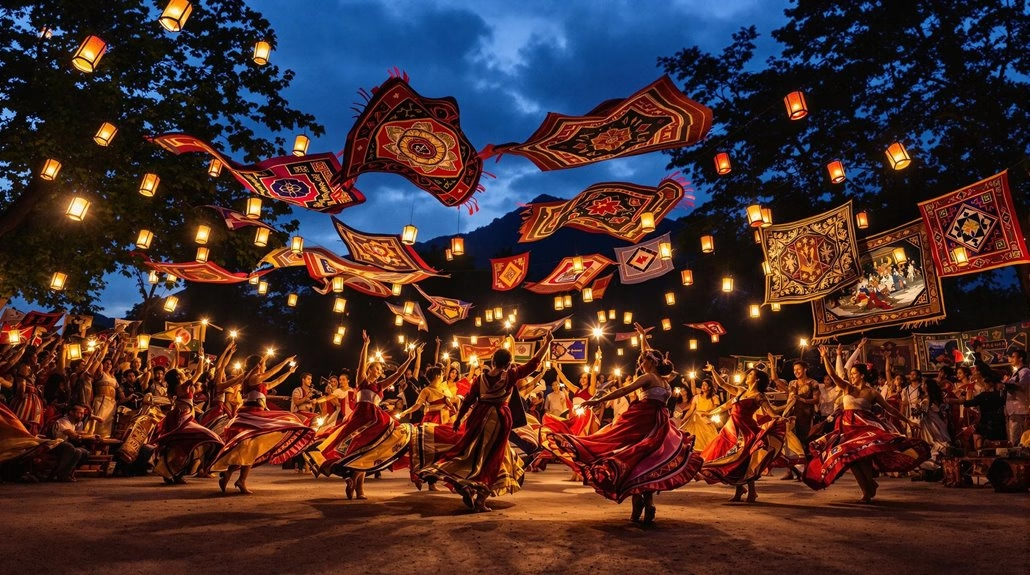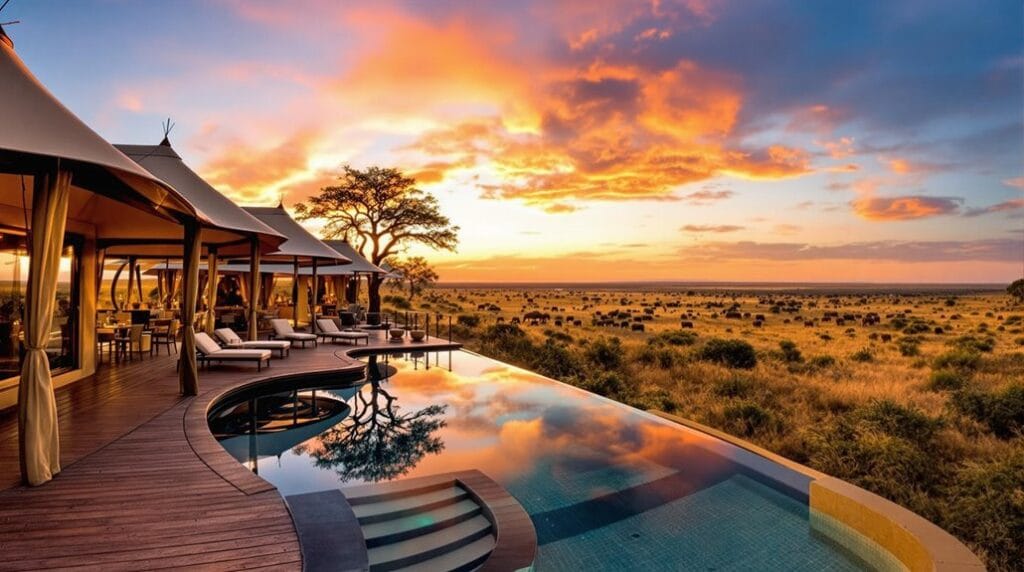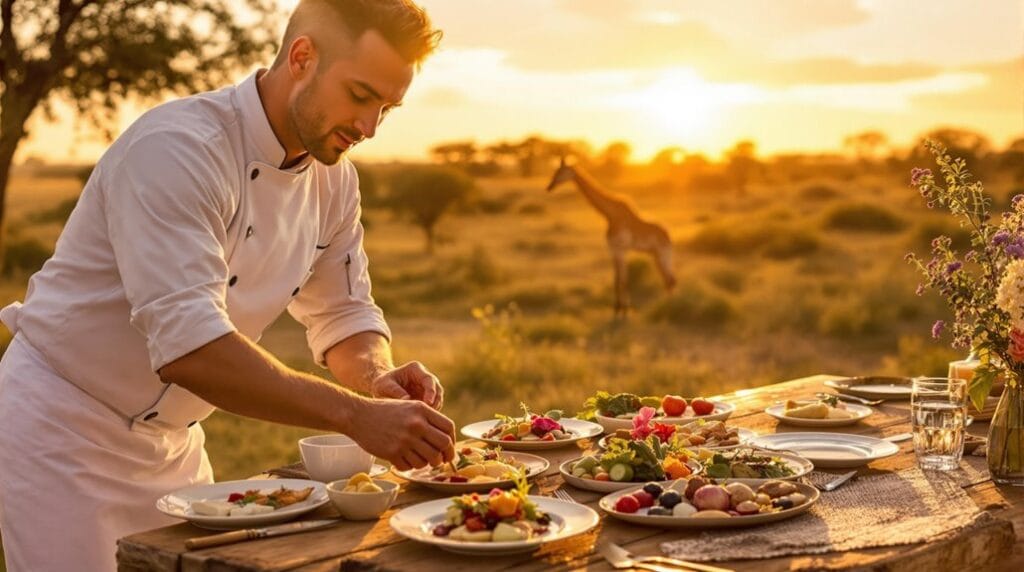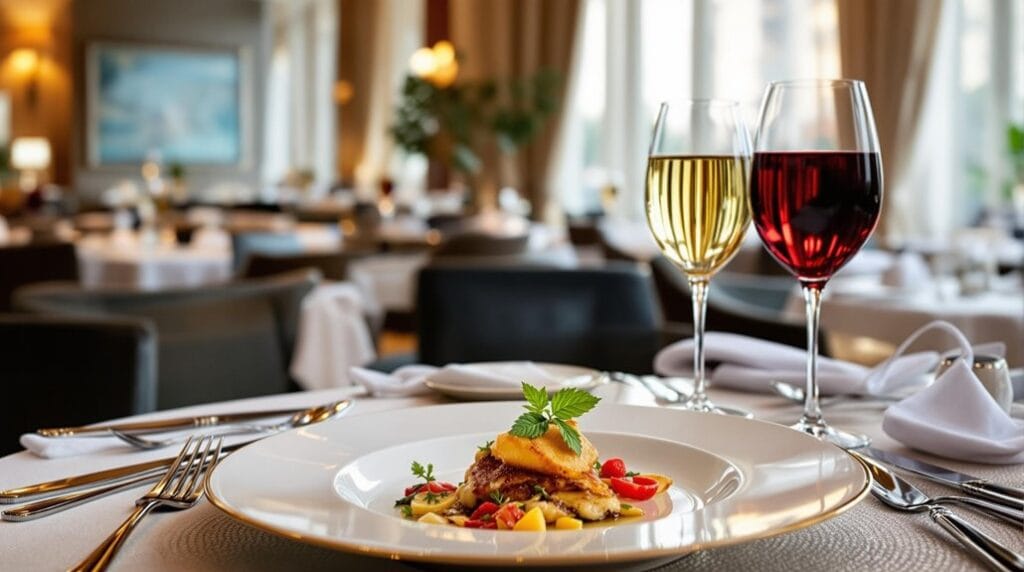Celebrating time-tested traditions through dance immerses you in a rich cultural tapestry that strengthens community bonds. Each rhythmic movement reflects the stories of resilience and shared history, inviting participation and connection. Day after day, vibrant festivals like Powwows showcase elaborate costumes that symbolize heritage and identity, enhancing the visual spectacle. As you engage with the music and drumming, you experience a transformative energy that promotes healing and unity. These celebrations not only honor the past but also cultivate a sense of belonging and joy. If you explore these cultural experiences further, you'll uncover even deeper meanings behind the dance.
Key Takeaways
- Cultural celebrations like Powwows and festivals unite communities, preserving traditions through dance and storytelling, fostering collective identity and resilience.
- Dance serves as a dynamic storytelling medium, allowing participants to express shared histories and personal experiences, enhancing emotional connections.
- Festive regalia and costumes symbolize cultural heritage and identity, enriching the visual experience of celebrations and deepening community ties.
- Drumming and traditional dance provide therapeutic outlets, promoting emotional release and strengthening communal bonds during celebratory events.
- Engaging in local festivals allows individuals to immerse themselves in cultural heritage, reinforcing the importance of traditions in contemporary society.
Importance of African Celebration Rituals
African celebration rituals are more than just events; they're vibrant expressions of culture that resonate with community and history. These rituals serve as essential touchstones for people, connecting them to their indigenous culture and the wisdom of their ancestors.
When you participate in ceremonies like weddings or harvest festivals, you're not just a spectator; you're engaging in a rich tapestry of traditional dances that embody profound spiritual meanings, fostering a sense of unity among participants.
The rhythmic drumming you hear isn't just music; it symbolizes communication with the spiritual domain, enhancing your emotional experience and drawing you deeper into the celebration.
As you don colorful attire and elaborate costumes, you're not merely dressing up; you're showcasing your cultural identity and social status, reinforcing your belonging within the community.
Oral traditions come alive during these celebrations, as stories and legends unfold, educating younger generations about their history and values.
In this way, African celebration rituals are significant, ensuring that the vibrancy of culture is passed down, creating a shared sense of belonging that unites people across generations.
Vibrant Traditions of African Festivals
When you step into an African festival, you can't help but feel the pulse of rhythm guiding your movements, as dance becomes a vibrant language of cultural storytelling.
Colorful costumes adorned with intricate beadwork not only celebrate individual identities but also weave together a rich tapestry of community and spiritual connection.
Here, every beat and every twirl honors ancestral traditions while inviting you to join in the joyous celebration of life.
Rhythm and Dance Heritage
Dance and rhythm pulse through the heart of many vibrant festivals across the continent, inviting you to immerse yourself in a rich tapestry of cultural heritage. Each festival unfolds stories through movement, where you can feel the energy of the community come alive.
- The intricate footwork of the Maasai's Adumu showcases their customs and history.
- Festivals like the Fes Festival of World Sacred Music in Morocco draw thousands, celebrating the beauty of diversity.
- Drumming resonates deeply, not just setting the rhythm but also conveying profound messages and emotions.
In these communal dances, you're not just an observer; you become part of a collective experience, fostering unity and social cohesion. Much like the special occasions celebrated by Native Americans, African festivals emphasize belonging, weaving together generations through shared rhythms.
You'll discover that every beat is a heartbeat of tradition, every step a connection to the past. The magic lies in your participation, as you dance alongside others, celebrating life and heritage. Embrace this rhythm, and let it guide you through the vibrant landscapes of culture and community, reminding you that you're never truly alone in your journey.
Colorful Costumes and Attire
At the heart of vibrant festivals, colorful costumes and attire serve as a powerful expression of cultural identity and heritage. These outfits, rich in tradition, reflect the unique stories of indigenous people, showcasing their history through intricate designs and vibrant colors.
Each festival highlights regional identities, with costumes often made from traditional textiles adorned with beads and symbols that convey deep cultural meanings.
As you immerse yourself in the festivities, notice how the elaborate headdresses and body paint enhance the visual spectacle. They're not just for show; they connect participants to their spiritual roots and ancestral traditions.
The use of vibrant attire during rituals and performances creates an atmosphere charged with energy and invites community participation, fostering a sense of belonging among all.
Costume-making is a communal activity, bringing families and communities together to craft outfits. This collaboration not only preserves cultural practices but also strengthens bonds between generations.
Just as Native American festivals celebrate their heritage through attire, African festivals do the same, reminding everyone that these colorful expressions are essential threads in the rich tapestry of cultural identity.
Embrace this vibrancy, and you'll feel the pulse of tradition in every stitch.
Community and Spiritual Connection
In countless African festivals, community and spirituality intertwine, creating a rich tapestry of vibrant traditions that resonate deeply with participants. These celebrations serve as a powerful reminder of the bonds that tie individuals together, fostering unity through shared experiences.
- Traditional dances, echoing the rhythms of ancestors, invite you to join in the celebration of life.
- Colorful costumes and intricate masks create a visual feast, symbolizing cultural identity and shared values.
- Rituals honoring natural elements and deities enrich the spiritual connection that many hold dear.
Take a moment to imagine the atmosphere during events like the Festival of the Lion King in Tanzania or the Fes Festival of World Sacred Music in Morocco. Here, stories come alive through music and dance, allowing participants to connect with their heritage.
These vibrant expressions of artistry aren't just for show; they embody the spirit of community and spirituality. By engaging in these traditions, you affirm your place within a larger narrative, celebrating not only personal milestones but also collective identity.
Ultimately, these festivals remind us that our roots and beliefs intertwine, creating a sense of belonging that enriches the human experience.
Dance as a Cultural Expression
When you watch a dance unfold, you're witnessing a powerful form of storytelling that transcends words, embodying the emotions and histories of a culture.
Each movement can serve as a healing gesture, connecting both performer and audience to a shared sense of identity and tradition.
Through the rhythmic expression of dance, you see how communities weave their narratives, celebrating their resilience and creativity in every step.
Healing Through Movement
Dance serves as a powerful conduit for healing, intertwining movement with cultural expression in profound ways. At powwows, traditional dances like the Jingle Dress Dance and Chicken Dance not only showcase vibrant artistry, but also serve as therapeutic outlets. As you move to the rhythm of the drum, you experience healing through movement, allowing personal burdens to dissipate and fostering a sense of communal connection.
Imagine the scene:
- The bright colors of regalia swirling in the sunlight,
- The deep, resonant beats of the drum echoing through your chest,
- The shared laughter and stories weaving through the air, creating a tapestry of resilience.
In this environment, people understand the emotional release that dance brings. Each step you take can facilitate clarity and foster a deeper sense of belonging.
The drumming, an essential heartbeat of the ceremony, amplifies these feelings, guiding you toward healing. As you participate in this age-old tradition, you become part of a collective journey, where the act of dancing transforms not just individuals, but entire communities.
Together, you cultivate a space for healing, growth, and celebration, honoring the legacies that define you.
Storytelling in Dance
At powwows, the fluid movements of dancers tell stories that resonate deeply within the community, connecting past and present. Each dance, whether it's the Jingle Dress Dance or the Chicken Dance, serves as a vibrant tapestry woven from cultural narratives and individual creativity.
You'll notice how dancers might use their bodies to embody legends, express personal experiences, or convey communal histories, all synchronized with the rhythmic beat of the drum.
Storytelling in dance goes beyond mere entertainment; it fosters a sense of belonging and shared identity. As you watch, you can feel the energy of the audience, who often participate, clapping and moving alongside the dancers. This interaction enhances the storytelling, making each performance a collective experience rather than a solitary one.
Moreover, alongside the dance performances, storytelling sessions enrich the cultural tapestry with humor and wisdom, further deepening your connection to these traditions.
In Indigenous cultures, dance isn't just a form of art; it's a spiritual expression that allows participants to release emotions and reconnect with their heritage. As you engage with these dances, you're not just an observer; you're part of a living narrative that celebrates resilience and community.
Community Bonds Through Celebrations
Celebrations play an essential role in weaving the fabric of community bonds, bringing people together through shared traditions and collective experiences. Whether it's the vibrant Powwows that unite families from various tribes or the Maibaum tradition in Germany that transforms neighborhoods into festive havens, these gatherings encourage people to connect deeply.
- Dance circles filled with laughter and rhythm
- Neighbors decorating birch trees with colorful ribbons
- Sunrise gatherings that echo with songs of resilience
These events foster inclusivity and engagement, reminding us that we're part of something larger. Indigenous Peoples Day, for instance, allows communities to stand together in solidarity, expressing their heritage while honoring the past.
In White Rock, May Day festivities ignite connections among residents through joyful parades and shared meals, creating a sense of belonging that lingers long after the celebrations end.
Even in the historical context of colonial Virginia, dance served as a bridge, inviting individuals from different social classes to mingle and celebrate together. Such experiences reinforce community bonds, showing us that through celebration, we cultivate relationships that enrich our lives and strengthen the ties that bind us.
Symbolism in Festive Regalia
Festive regalia serves as a vivid expression of cultural heritage and personal identity, intricately woven into the fabric of community celebrations. When you witness regalia at powwows, you realize it's not just a costume; it's a powerful symbol, often passed down through generations. Each piece, from elaborate headdresses crafted from porcupine and deer hair to intricate beaded accessories, showcases an authentic Indigenous identity, celebrating the diversity within the community.
The symbolism extends beyond individual expression. For example, the gift-giving traditions during powwows, where blankets are presented to signify warmth and strength, reinforce the bonds between families and the broader community. These practices remind everyone of their interconnectedness and shared history.
Similarly, in German celebrations, the Maibaum tradition of decorating birch trees with colorful ribbons acts as a public declaration of love, fostering a sense of belonging.
In White Rock, the costume distinctions during May Day celebrations reflect societal expectations, emphasizing how identity is shaped by community norms. As you engage with these festive regalia, you're not just an observer; you're brought together with a rich tapestry of stories and meanings, deepening your connection to the cultural heritage around you.
Healing and Spiritual Significance
Healing and spiritual significance resonate deeply within the vibrant atmosphere of powwows, where the rhythmic pulse of drums invites participants to engage in a transformative experience. As you step into this sacred space, you can feel the energy shift, creating a collective rhythm that fosters healing.
- The deep, resonant beats of drums echo the heartbeat of the earth, grounding you in the moment.
- Dancers move gracefully, their bodies telling stories of struggle and triumph, allowing emotional release.
- The warm embrace of community surrounds you, uniting everyone in a shared journey of resilience.
In this environment, drumming serves as a central healing element, guiding you toward clarity and emotional release. Traditional dancing becomes a therapeutic outlet, enabling individuals to express burdens and contribute to communal healing.
The shared experiences during powwows emphasize the importance of togetherness in Indigenous cultures. You witness firsthand how these life-affirming events not only celebrate cultural heritage but also foster resilience and recovery within communities.
As you partake in this vibrant celebration, you can sense the healing power that music and movement bring, binding you to a larger narrative of belonging and emotional well-being.
Cultural Travel and Heritage Experiences
Experiencing the vibrant traditions of local festivals can profoundly enhance your understanding of cultural heritage while fostering a sense of connection to the community. Cultural travel immerses you in the rich tapestry of local customs, allowing you to witness the resilience and spirit of various groups.
| Festival | Key Features |
|---|---|
| Powwows | Traditional dance, music, storytelling |
| Indigenous Peoples Day | Sunrise gatherings, performances, cultural immersion |
| May Day (Germany) | Maibaum decoration, community spirit festivities |
| Beltane (North America) | Maypole dancing, live music, communal feasting |
Participating in events like Indigenous Peoples Day not only honors history but also invites reflection on the past injustices faced by Indigenous communities. Festivals such as May Day and Beltane offer an opportunity to connect with ancient traditions, fostering intergenerational bonds and cultural continuity.
When you engage with these local celebrations, you celebrate not just the events themselves, but the stories, struggles, and triumphs that shape identities. These experiences enrich your journey, creating lasting memories and a profound sense of belonging in the tapestry of humanity.
Frequently Asked Questions
What Are the Dance Traditions in America?
When you explore dance traditions in America, you'll find vibrant styles like swing dancing and line dancing that invite everyone to join in.
Swing dancing, with its lively rhythms and improvisational flair, creates an electric atmosphere where you can connect with others.
Line dancing, often seen at parties and community gatherings, fosters a sense of unity as participants move together in synchrony.
These forms reflect America's rich cultural tapestry, celebrating inclusivity and shared joy through movement.
What Is the Maibaum Tradition?
Have you ever stumbled upon a decorated birch tree and wondered about its story?
That's the Maibaum tradition, rooted in Maypole history, symbolizing love and community. Men express affection by erecting these trees, adorned with colorful ribbons, at their beloved's home, while neighbors join in the celebration.
This tradition fosters camaraderie, as men guard the Maibaum overnight, ensuring their gesture of love remains a cherished experience, rich in Maibaum significance.
What Cultures Use Dance to Tell Stories?
Many cultures use dance to tell stories, creating a vibrant tapestry of expression.
In African storytelling, rhythm and movement convey deep cultural narratives. Native American powwows showcase individualized dances that honor heritage.
Indian classical dance depicts mythological tales, while Spanish flamenco expresses passion and history.
Polynesian hula captures ancestral stories through graceful movements, and Russian folk dance reflects community life and traditions.
Each dance invites you to connect, understand, and celebrate diverse cultural legacies.
What Is a Powwow Celebration?
A powwow celebration is like a tapestry woven with vibrant threads of culture and community. It holds significant powwow history, bringing together Native Americans to honor their heritage through dance, music, and storytelling.
You'll experience emotional healing and connection as participants share their stories and traditions. These gatherings create a sense of belonging, fostering unity among diverse tribes and generations, making each powwow a beautiful celebration of life and identity.
Conclusion
As you immerse yourself in the vibrant rhythms and colorful regalia of African celebrations, you'll find a tapestry woven with both joy and reverence. The pulse of the drum echoes not just in the feet of the dancers but in the hearts of the community, binding generations together. While the festivities spark laughter and connection, they also carry a deep spiritual significance, reminding you that in every dance lies a story of resilience and unity.








